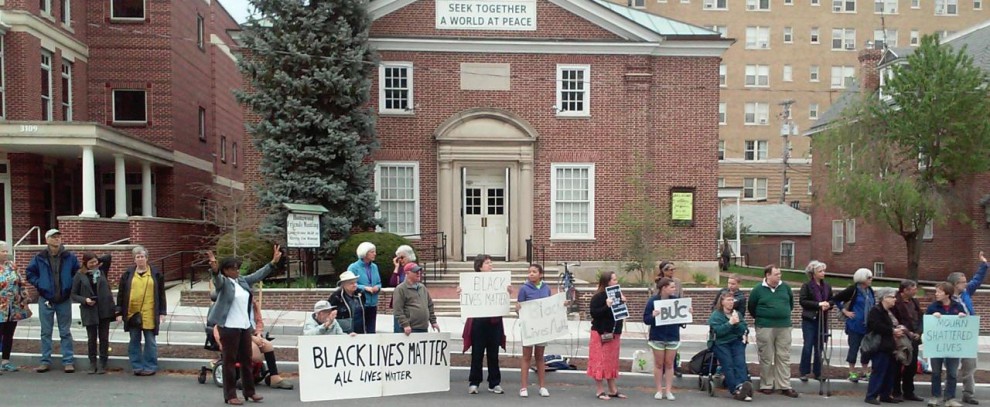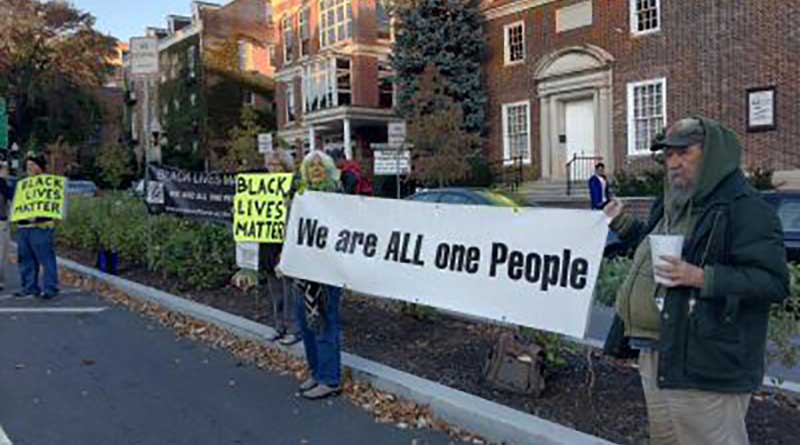
On Monday, April 27, around 5 p.m., I was driving home from the West Baltimore train station after a day at work. Newscasters on the radio were reporting on the funeral of Freddie Gray that had happened a few hours before. My first awareness of a problem was the sight of rows of police in riot gear lining intersections along Route 40. I decided that it would be best to turn left on North Charles Street, which is located in the center of the city and considered to be a safe place in Baltimore. There were no police in sight.
I stopped at a traffic light below the Washington Monument and noticed a woman in front of me on a motorcycle with long red hair streaming down her back. She was dressed all in black and wearing a black helmet with a clear face shield. Perhaps some might observe her outfit and misidentify her as police. Then I noticed a bevy of movement: African American teenagers streaming in and out of the 7-Eleven store at the corner. Suddenly about a dozen of teenagers converged on the motorcyclist in front of me. Their eyes were blind with rage. She drove her bike about 10 feet ahead into the intersection and then they pulled her down and started beating and kicking her. They are going to kill her, I thought. Immediately I knew what to do. I put my hand on the horn and held it down as I slowly moved forward, stopping about two feet from the motorcycle. The horn was deafening. The crowd momentarily dispersed.
I put down my window and called to the woman, “Get in the car.” I unlocked the doors, and she ran to the car and got in behind me. Before I could lock the doors, one teenager wearing a black hood with a face mask opened the other back door and leapt inside the car. He was so young. His eyes met mine. They blazed with hate. I felt a sharp blow on my back. Then he lunged toward the motorcyclist. She opened her car door and ran, and he disappeared out the opposite door. Now I found myself stopped in the middle of an angry mob of teenagers with both back doors open. I put my foot on the gas and zoomed forward with no attention to the intersection before me. The Red Sea must have parted for I made it safely through the intersection and flew up the hill toward the Washington Monument. Clear of the melee, I parked the car and peered down the hill to see if I could spot the woman with the long red hair. There was no sign of her, and the crowd was dispersing. I hope she escaped further harm.
I looked around and noticed a terrified-looking young Indian man standing next to my parked car. He asked, “What is going on?” For the second time in a couple of minutes, I found myself saying, “Get in the car.” He told me he had been in Baltimore for just a few weeks. “Welcome to Baltimore.” I drove around the block to his apartment building and asked him to pray for Baltimore as he departed.
After arriving home, I ran into the house crying and moaning. My husband, Gary, and my tall, thin 19-year-old son, Devin, consoled me. Devin held both my hands, saying, “Calm down, Mom. It is okay. We are in meeting for worship now. Breathe deeply.” My hysteria abated. Gary went out to the car and came back announcing that he had found the weapon: a large bottle of Sprite that probably was lifted from the looted 7-Eleven store.
Those of us who live in Baltimore are not surprised by the massive, hostile response to Gray’s death while in police custody. A match was lit next to a pile of already existing dynamite: suppressed rage at generational poverty, lack of opportunity, lack of jobs, poor education, an epidemic of drug addiction, and longstanding problems of excessive use of force by the Baltimore Police Department. Most of the media have primarily focused on the riots and the destruction; far less attention has been paid to the amazing, constructive work in and by the community recently to respond in positive ways: clean-ups, food drives, nonviolent marches and rallies, and outspoken community support to deter the demonstrators from clashing with police over the 10 p.m. curfew.
I am so inspired by Representative Elijah Cummings who has been out in his neighborhood every night exhorting young people to engage in the political process and not in violence. I burst into tears of joy and relief when I heard Marilyn Mosby, the state’s attorney for Baltimore, announce that charges were being brought against the six Baltimore police officers involved in Gray’s death. She concluded her speech: “To the people of Baltimore and the demonstrators across America: I heard your call for ‘No justice, no peace.’ Your peace is sincerely needed as I work to deliver justice on behalf of this young man.” Many Baltimoreans are convinced her quick and decisive action saved us from more violence.
I am healing from a nasty bruise and the shock following my unexpected foray into the riots in Baltimore. I have a new window of understanding into the experience of so many in the world who live in the midst of indiscriminate violence. How do they cope? I have felt no anger toward those raging young men and am surprised when others who hear this story express anger. The hate I saw in their eyes and the violent frenzy that I witnessed is not normal. It is a symptom of lives that have been unbearably difficult, of coming into adulthood with no real opportunity, of living with constant fear of the police. I am appalled to hear our mayor and president refer to these young men as “thugs.” Labeling people and calling them names is not helpful.
The night of the riot I felt compelled to reach out to my handful of close friends who are black. I needed to absorb their love for me. After consoling me, my friend Ellis said, “Sarah, if they had known who you are, they never would have done this to you.”
Two days later, I participated in our weekly Experiment with Light group at Homewood Meeting in Baltimore. (Experiment with Light is a guided meditation developed by British Friend Rex Ambler that is thought to engage the worship experience of early Friends.) During the meditation I realized that I had been focusing on being a victim. I heard the prompts: “Keep a little distance so you can see it clearly. Let the Light show you what is really going on.” I found myself back in the car. There had been no question about what I needed to do to intervene in the attack on the woman with the long red hair. The Light showed me the way. Love stopped the attack. Love prevented riots in the ensuing days. Love propelled Elijah Cummings as he walked through the crowd night after night with a bullhorn asking his neighbors to go home. Love is more powerful than hate.
On Friday evening after Marilyn Mosby’s astonishing announcement, Baltimore Quakers stood in front of Homewood Meeting for our weekly peace vigil with a huge sign that read “Black Lives Matter / All Lives Matter.” The responses of those driving by were so positive—horns were honking and people were waving. I was glad to stand there among Friends, including our Baltimore Yearly Meeting clerk and general secretary who drove up from the Washington, D.C., area to support us. Afterward the Baltimore Quaker Peace and Justice Committee met to explore next steps. There is recognition that “this is our time,” the time when real progress can be made to address the problems in Baltimore and cities all over the United States. Friends, the time is now—for us to open our hearts, to yield to the infinite power of divine love, and to discern what it would have us do.




Comments on Friendsjournal.org may be used in the Forum of the print magazine and may be edited for length and clarity.